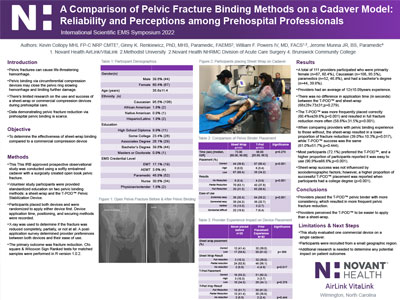ABSTRACTS
A Comparison of Pelvic Fracture Binding Methods on a Cadaver Model: Reliability and Perceptions among Prehospital ProfessionalsAuthor: Kevin Collopy | | Associate Authors: Jerome Munna, Jr. | Ginny K. Renkiewicz | William F. Powers
Introduction Pelvic fractures can cause life-threatening hemorrhage. Pelvic binding via circumferential compression devices may close the pelvic ring, slowing hemorrhage and limiting further damage. There is limited research on the use and success of a sheet-wrap or commercial compression devices during prehospital care. Data demonstrating pelvic fracture reduction via prehospital pelvic binding is scarce. Objective To determine the effectiveness of sheet-wrap pelvic binding compared to a commercial compression device. Methods This IRB approved prospective observational study was conducted using a softly embalmed cadaver with a surgically created, open-book pelvic fracture. Volunteer study participants were provided standardized education on 2 pelvic binding methods: a sheet-wrap and the T-POD™ Pelvic Stabilization Device. Participants placed both devices and were randomized to apply either device first. Device application time, positioning, and securing methods were recorded. X-ray was used to determine if the fracture was reduced completely, partially, or not at all. A post-application survey determined provider preferences between both devices and their ease of use. The primary outcome was fracture reduction. Chi-square and Wilcoxon Sign Ranked tests for matched samples were performed in R version 1.0.2. Results A total of 111 providers participated who were primarily female (N = 67, 60.4%), White (N = 106, 95.5%), paramedics (N = 52, 46.8%), and had a bachelor’s degree (N=44, 39.6%). Providers had an average of 12 ± 10.09 years’ experience. There was no difference in application time (in seconds) between the T-POD™ and sheet-wrap (68 ± 28 vs 73 ± 31; P = 0.279). The T-POD™ was more frequently placed correctly (60.4% vs 39.6%; P < 0.001) and resulted in full fracture reduction more often (58.6% vs 31.5%;P < 0.001). When comparing providers with pelvic binding experience to those without, the sheet-wrap resulted in a lower proportion of fracture reduction (39.0% vs 10.3%; P = 0.017), while T-POD™ success was the same (61.0% vs 51.7%; P = 0.444). Most participants (72.1%) preferred the T-POD™, and a higher proportion of participants reported it was easy to use (90.9% vs 66.6%; P < 0.001). Sheet-wrap success was not influenced by sociodemographic factors; however, a higher proportion of successful T-POD™ placement was reported when participants had a college degree (P < 0.001).
Conclusion
|

